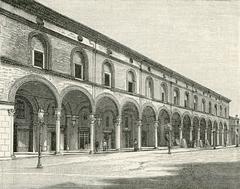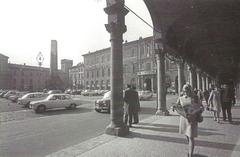Porta Montanara Visiting Hours, Tickets, and Travel Guide: Imola’s Iconic Historical Gate
Date: 14/06/2025
Introduction: History and Significance of Porta Montanara
Porta Montanara, located in the heart of Imola, Italy, is an enduring symbol of the city’s layered history, from its Roman origins through medieval transformations and into the present day. Originally built in the 1st century BCE as part of Imola’s Roman city walls, the gate once marked a primary entrance along the ancient Via Emilia—one of Rome’s most important roads connecting the major cities of northern Italy (Patrimonio Culturale Emilia-Romagna; tiraccontounviaggio.it).
Over centuries, Porta Montanara evolved, reflecting the city’s strategic and political importance. The medieval period saw the gate integrated into Imola’s new defensive walls under the Manfredi family (15th century), with distinctive features such as Ghibelline merlons and robust masonry (visitareimola.it; turismoimolese.cittametropolitana.bo.it). Despite the destruction of much of the city’s fortifications in the 20th century, Porta Montanara has survived as the only remaining medieval gate, beautifully restored and freely accessible to visitors.
Surrounded by other major landmarks like the Rocca Sforzesca and Palazzo Tozzoni, Porta Montanara is an ideal starting point for exploring Imola’s rich urban and cultural heritage (visititaly.com; Imola Tourism). Today, it stands as a testament to Imola’s resilience, inviting visitors to discover its historical layers through guided tours, heritage trails, and local events.
Origins and Architectural Evolution
Roman Foundations
Constructed as part of Imola’s original Roman defenses, Porta Montanara was one of four principal gates in the city walls of Forum Cornelii (ancient Imola). Built from large arenaria (sandstone) blocks, the gate featured two arches (fornici), facilitating access to the Via Aretina and the Apennine hinterland. Its location at the terminus of the Cardine Massimo—the city’s main north-south axis—underscored its strategic role in trade, military movement, and urban planning (Patrimonio Culturale Emilia-Romagna; NewsBreak).
Medieval Transformations
During the Middle Ages, Porta Montanara was reimagined as part of the “Manfrediana” walls under the Manfredi family (1460–1472). The gate was fortified with thick masonry and Ghibelline merlons—swallowtail battlements indicative of the city’s political allegiances during the Guelph-Ghibelline conflicts (visitareimola.it). The name “Montanara” (“of the mountains”) references its southern orientation toward the Apennines.
Integration with the city’s evolving defenses included moats, ramparts, and proximity to the Rocca Sforzesca, Imola’s imposing fortress. The gate’s square base and robust construction exemplified medieval military architecture, while also serving as a civic symbol for Imola’s inhabitants (turismoimolese.cittametropolitana.bo.it).
Modern Era and Restoration
The 20th century saw the demolition of much of Imola’s medieval walls, and Porta Montanara suffered significant damage during World War II. Restoration efforts in 2004 led to its careful reconstruction and reinstallation, restoring the surviving arch and integrating it into the modern cityscape (Patrimonio Culturale Emilia-Romagna). Today, Porta Montanara stands as a touchstone of Imola’s ancient roots and a focus of civic identity (NewsBreak).
Architectural Features
- Material: Constructed from local sandstone and brick, the gate’s arches are a testament to Roman engineering.
- Merlons: Ghibelline merlons crown the medieval superstructure, providing both defense and symbolic value.
- Design: The gate’s plan is square, with one surviving arch visible today. Its robust, functional style reflects centuries of adaptation.
- Integration: Aligned with the Via Emilia and Via Aretina, Porta Montanara facilitated trade and connected Imola to the wider region.
- Restoration: Recent efforts have stabilized the structure, added interpretive signage, and enhanced accessibility while preserving original features (nonsoloisole.it).
Visiting Porta Montanara: Hours, Tickets, and Accessibility
- Visiting Hours: Porta Montanara is an open-air monument, accessible 24 hours a day, year-round.
- Tickets: Admission is free; no tickets are required.
- Accessibility: The site is wheelchair accessible, with pedestrian pathways linking it to the city center and nearby attractions.
- Guided Tours: Local tourism offices and cultural associations offer guided tours that include Porta Montanara. Check schedules and availability on the Imola Tourism website.
- Location: Located on Via Nino Bixio, a short walk from Rocca Sforzesca, Piazza Matteotti, and other major landmarks. Public transport and parking are available nearby (tiraccontounviaggio.it).
Nearby Attractions and Cultural Experiences
Enhance your visit to Porta Montanara with these nearby highlights:
- Rocca Sforzesca: Renaissance fortress hosting exhibitions and panoramic views (check current restoration status before visiting).
- Palazzo Tozzoni: Noble residence and museum with period furnishings.
- Duomo di San Cassiano: Imola’s cathedral, renowned for neoclassical architecture.
- Piazza Matteotti: Main square, vibrant with markets and local life.
- Walking Tours: Many guided tours include Porta Montanara as a key stop (visitareimola.it).
Special Events and Local Culture
Porta Montanara often features in local festivals, historical reenactments, and educational programs. It also serves as a backdrop for photography, community gatherings, and municipal branding. Check Imola’s official tourism website for updates on upcoming events and tours.
Preservation and Community Engagement
Imola’s commitment to preserving Porta Montanara reflects the city’s dedication to its historical identity. Local authorities and heritage organizations ensure ongoing maintenance and community engagement through cultural initiatives, interpretive signage, and educational outreach (nonsoloisole.it).
Frequently Asked Questions (FAQ)
Q: What are the visiting hours for Porta Montanara?
A: Porta Montanara is accessible 24/7, year-round.
Q: Is there an entrance fee?
A: No, visiting Porta Montanara is free.
Q: Are guided tours available?
A: Yes, check with the local tourism office for available walking tours that include Porta Montanara.
Q: Is the site wheelchair accessible?
A: Yes, the area is flat and accessible, with paved pathways.
Q: What other attractions are nearby?
A: Rocca Sforzesca, Palazzo Tozzoni, Duomo di San Cassiano, and Piazza Matteotti are all within walking distance.
Practical Visitor Tips
- Best Visiting Times: Early morning or late afternoon for ideal lighting and fewer crowds.
- Photography: The arches and city views make for excellent photo opportunities.
- Combine Visits: Explore other historical sites in the same trip for a comprehensive experience.
- Parking: Paid parking is available nearby; free public lots are within a 10-minute walk (tiraccontounviaggio.it).
Visual & Interactive Elements
 Alt text: Porta Montanara, historic medieval gate with distinctive Ghibelline merlons in Imola, Italy.
Alt text: Porta Montanara, historic medieval gate with distinctive Ghibelline merlons in Imola, Italy.
For more images, maps, and virtual tours, visit the official Imola tourism site.
Key Facts
- Construction: 1st century BCE (Roman origins), rebuilt in the 15th century (Manfredi era) (visitareimola.it).
- Material: Sandstone and brick.
- Survival: The only remaining gate of Imola’s original four.
- Location: Via Nino Bixio, south side of Imola’s historic center.
Summary and Final Visitor Advice
Porta Montanara is a living testament to Imola’s transformation through Roman, medieval, and modern eras. Its enduring architectural features, free access, and proximity to other major landmarks make it a must-see for history enthusiasts and casual visitors alike. Enhance your experience by joining a guided tour, exploring local events, and using official tourism resources for the latest information.
Plan your visit today and immerse yourself in the rich tapestry of Imola’s past and present at Porta Montanara.


